Occurrence and Distribution of Uranium in a Hydrological Cycle around a Uranium Mill Tailings Pond, Southern China
Abstract
1. Introduction
2. Materials and Methods
2.1. Study Area
2.2. Sample Collection and Analysis
2.2.1. Sampling
2.2.2. Analysis
3. Results and Discussion
3.1. Tailings Sand Samples
3.2. Percolating Water Samples
3.3. Paddy Soil Samples
3.4. Groundwater Samples
4. Conclusions
Author Contributions
Funding
Acknowledgments
Conflicts of Interest
References
- Abdelouas, A. Uranium Mill Tailings: Geochemistry, Mineralogy, and Environmental Impact. Elements 2006, 2, 335–341. [Google Scholar] [CrossRef]
- Yan, X.; Luo, X. Radionuclides distribution, properties, and microbial diversity of soils in uranium mill tailings from southeastern China. J. Environ. Radioactiv. 2015, 139, 85–90. [Google Scholar] [CrossRef]
- Nair, R.N.; Sunny, F.; Manikandan, S.T. Modelling of decay chain transport in groundwater from uranium tailings ponds. Appl. Math. Model. 2010, 34, 2300–2311. [Google Scholar] [CrossRef]
- Costa, M.R.; Pereira, A.J.S.C.; Neves, L.J.P.F.; Ferreira, A. Potential human health impact of groundwater in non-exploited uranium ores: The case of Horta da Vilariça (NE Portugal). J. Geochem. Explor. 2017, 183, 191–196. [Google Scholar] [CrossRef]
- Banning, A.; Rüde, T.R.; Dölling, B. Crossing redox boundaries—Aquifer redox history and effects on iron mineralogy and arsenic availability. J. Hazard. Mater. 2013, 262, 905–914. [Google Scholar] [CrossRef]
- Teixeira, J.; Chaminé, H.I.; Marques, J.E.; Carvalho, J.M.; Pereira, A.J.S.C.; Carvalho, M.R.; Fonseca, P.E.; Pérez-Alberti, A.; Rocha, F. A comprehensive analysis of groundwater resources using GIS and multicriteria tools (Caldas da Cavaca, Central Portugal): environmental issues. Environ. Earth Sci. 2015, 73, 2699–2715. [Google Scholar] [CrossRef]
- UNSCEAR. Sources, Effects and Risks of Ionizing Radiation; United Nations Scientific Committee on the Effects of Atomic Radiation: New York, NY, USA, 2016. [Google Scholar]
- Wang, X.; Ni, S.; Shi, Z. Uranium distribution in the sediment of the Mianyuan River near a phosphate mining region in China and the related uranium speciation in water. Geochemistry 2014, 74, 661–669. [Google Scholar] [CrossRef]
- Sharma, T.; Sharma, A.; Kaur, I.; Mahajan, R.K.; Litoria, P.K.; Sahoo, S.K.; Bajwa, B.S. Uranium distribution in groundwater and assessment of age dependent radiation dose in Amritsar, Gurdaspur and Pathankot districts of Punjab, India. Chemosphere 2019, 219, 607–616. [Google Scholar] [CrossRef] [PubMed]
- Wufuer, R.; Song, W.; Zhang, D.; Pan, X.; Gadd, G.M. A survey of uranium levels in urine and hair of people living in a coal mining area in Yili, Xinjiang, China. J. Environ. Radioactiv. 2018, 189, 168–174. [Google Scholar] [CrossRef]
- Lourenço, J.; Pereira, R.; Pinto, F.; Caetano, T.; Silva, A.; Carvalheiro, T.; Guimarães, A.; Gonçalves, F.; Paiva, A.; Mendo, S. Biomonitoring a human population inhabiting nearby a deactivated uranium mine. Toxicology 2013, 305, 89–98. [Google Scholar] [CrossRef]
- Landa, E.R. Uranium mill tailings: nuclear waste and natural laboratory for geochemical and radioecological investigations. J. Environ. Radioactiv. 2004, 77, 1–27. [Google Scholar] [CrossRef] [PubMed]
- Wu, Y.; Wang, Y.; Xie, X. Occurrence, behavior and distribution of high levels of uranium in shallow groundwater at Datong basin, northern China. Sci. Total Environ. 2014, 472, 809–817. [Google Scholar] [CrossRef]
- Gao, L.; Kano, N.; Sato, Y.; Li, C.; Zhang, S.; Imaizumi, H. Behavior and distribution of heavy metals including rare Earth elements, thorium, and uranium in sludge from industry water treatment plant and recovery method of metals by biosurfactants application. Bioinorg. Chem. Appl. 2012, 2012, 173819. [Google Scholar] [CrossRef]
- Galhardi, J.A.; García-Tenorio, R.; Bonotto, D.M.; Díaz-Francés, I.; Motta, J.G. Natural radionuclides in plants, soils and sediments affected by U-rich coal mining activities in Brazil. J. Environ. Radioactiv. 2017, 177, 37–47. [Google Scholar] [CrossRef]
- Mishra, S.; Kasar, S.; Takamasa, A.; Veerasamy, N.; Sahoo, S.K. Measurement of uranium distribution coefficient and (235)U/(238)U ratio in soils affected by Fukushima dai-ichi nuclear power plant accident. J. Environ. Radioactiv. 2019, 198, 36–42. [Google Scholar] [CrossRef] [PubMed]
- Gaskova, O.L.; Boguslavsky, A.E. Groundwater Geochemistry Near the Storage Sites of Low-level Radioactive Waste: Implications for Uranium Migration. Earth Planet. Sc. Lett. 2013, 7, 288–291. [Google Scholar] [CrossRef]
- Antunes, I.M.H.R.; Albuquerque, M.T.D.; Seco, M.F.M.; Oliveira, S.F.; Sanz, G. Uranium and Arsenic Spatial Distribution in the Águeda Watershed Groundwater. Earth Planet. Sc. Lett. 2014, 8, 13–17. [Google Scholar] [CrossRef][Green Version]
- Xie, Y.; Chen, C.; Ren, X.; Wang, X.; Wang, H.; Wang, X. Emerging natural and tailored materials for uranium-contaminated water treatment and environmental remediation. Prog. Mater. Sci 2019, 103, 180–234. [Google Scholar] [CrossRef]
- Pereira, W.D.S.; Kelecom, A.G.A.C.; da Silva, A.X.; do Carmo, A.S.; Py Júnior, D.D.A. Assessment of uranium release to the environment from a disabled uranium mine in Brazil. J. Environ. Radioactiv. 2018, 188, 18–22. [Google Scholar] [CrossRef] [PubMed]
- 21. Melo, D.; Burkart, W. Uranium: Environmental Pollution and Health Effects. In Encyclopedia of Environmental Health; Nriagu, J.O., Ed.; Elsevier: Burlington, MA, USA, 2011; pp. 526–533. [Google Scholar]
- Liu, B.; Peng, T.; Sun, H.; Yue, H. Release behavior of uranium in uranium mill tailings under environmental conditions. J. Environ. Radioactiv. 2017, 171, 160–168. [Google Scholar] [CrossRef]
- He, J.L.; Xu, G.Y. Study on the Background Value of Soil Environment in Jiangxi Province; China Environmental Science Press: Beijing, China, 2006. [Google Scholar]
- Zielinski, R.A.; Simmons, K.R.; Orem, W.H. Use of 234U and 238U isotopes to identify fertilizer-derived uranium in the Florida Everglades. Appl. Geochemistry 2000, 15, 369–383. [Google Scholar] [CrossRef]
- Arthur, S.R.; Helen, A.G.; Mohler, H.J.; Kathleen, R.M.; Paul, G.V.; John, E.T. Reconstruction of atmospheric concentrations of enriched uranium from the former Apollo facility, Apollo, Pennsylvania, USA. J. Environ. Radioactiv. 2020, 211, 1–24. [Google Scholar]
- Santos-Francés, F.; Gil Pacheco, E.; Martínez-Graña, A.; Alonso Rojo, P.; Ávila Zarza, C.; García Sánchez, A. Concentration of uranium in the soils of the west of Spain. Environ. Pollut. 2018, 236, 1–11. [Google Scholar] [CrossRef] [PubMed]
- Orozco-Duran, A.; Daessle, L.W.; Gutierrez-Galindo, E.A.; Munoz-Barbosa, A. Distribution of selenium, molybdenum and uranium in sediment cores from the Colorado River delta, Baja California, Mexico. Bull. Environ. Contam. Toxicol. 2012, 88, 104–107. [Google Scholar] [CrossRef]
- Nassour, M.; Weiske, A.; Schaller, J.; Brackhage, C.; Gert Dudel, E. Distribution and relationship of uranium and radium along an allochthonously dominated wetland gradient. Arch. Environ. Contam. Toxicol. 2015, 68, 317–322. [Google Scholar] [CrossRef]
- Bachmaf, S.; Planerfriedrich, B.; Merkel, B.J. Competitive sorption and desorption of arsenate and uranium on bentonite and kaolinite. Geochim. Cosmochim. Acta 2009, 73. [Google Scholar] [CrossRef]
- Wang, W.H.; Luo, X.G.; Wang, Z.; Zeng, Y.; Wu, F.Q.; Li, Z.X. Heavy Metal and Metalloid Contamination Assessments of Soil around an Abandoned Uranium Tailings Pond and the Contaminations’ Spatial Distribution and Variability. Inter. J. Env. Res. Pub. Heal. 2018, 15, 2401. [Google Scholar] [CrossRef]
- Gas’kova, O.L.; Boguslavskii, A.E.; Sirotenko, T.G. Geochemical composition of natural waters near a storage site of low-activity radioactive wastes. Water Resour. 2011, 38, 597–607. [Google Scholar] [CrossRef]
- Anita, E.; Katalin, C.; Bálint, I.; Márta, V.; Ákos, H.; Tamás, P. Uranium in groundwater-The importance of hydraulic regime and groundwater flow system’s understanding. J. Environ. Radioactiv. 2018, 195, 90–96. [Google Scholar]
- Pashalidis, I.; Tsertos, H. Radiometric determination of uranium in natural waters after enrichment and separation by cation-exchange and liquid-liquid extraction. J. Radioanal. Nucl. Chem. 2004, 260, 439–442. [Google Scholar] [CrossRef]
- Shin, W.; Oh, J.; Choung, S.; Cho, B.W.; Lee, K.S.; Yun, U.; Woo, N.C.; Kim, H.K. Distribution and potential health risk of groundwater uranium in Korea. Chemosphere 2016, 163, 108–115. [Google Scholar] [CrossRef] [PubMed]
- Kayzar, T.M.; Villa, A.C.; Lobaugh, M.L.; Gaffney, A.M.; Williams, R.W. Investigating uranium distribution in surface sediments and waters: a case study of contamination from the Juniper Uranium Mine, Stanislaus National Forest, CA. J. Environ. Radioactiv. 2014, 136, 85–97. [Google Scholar] [CrossRef] [PubMed]
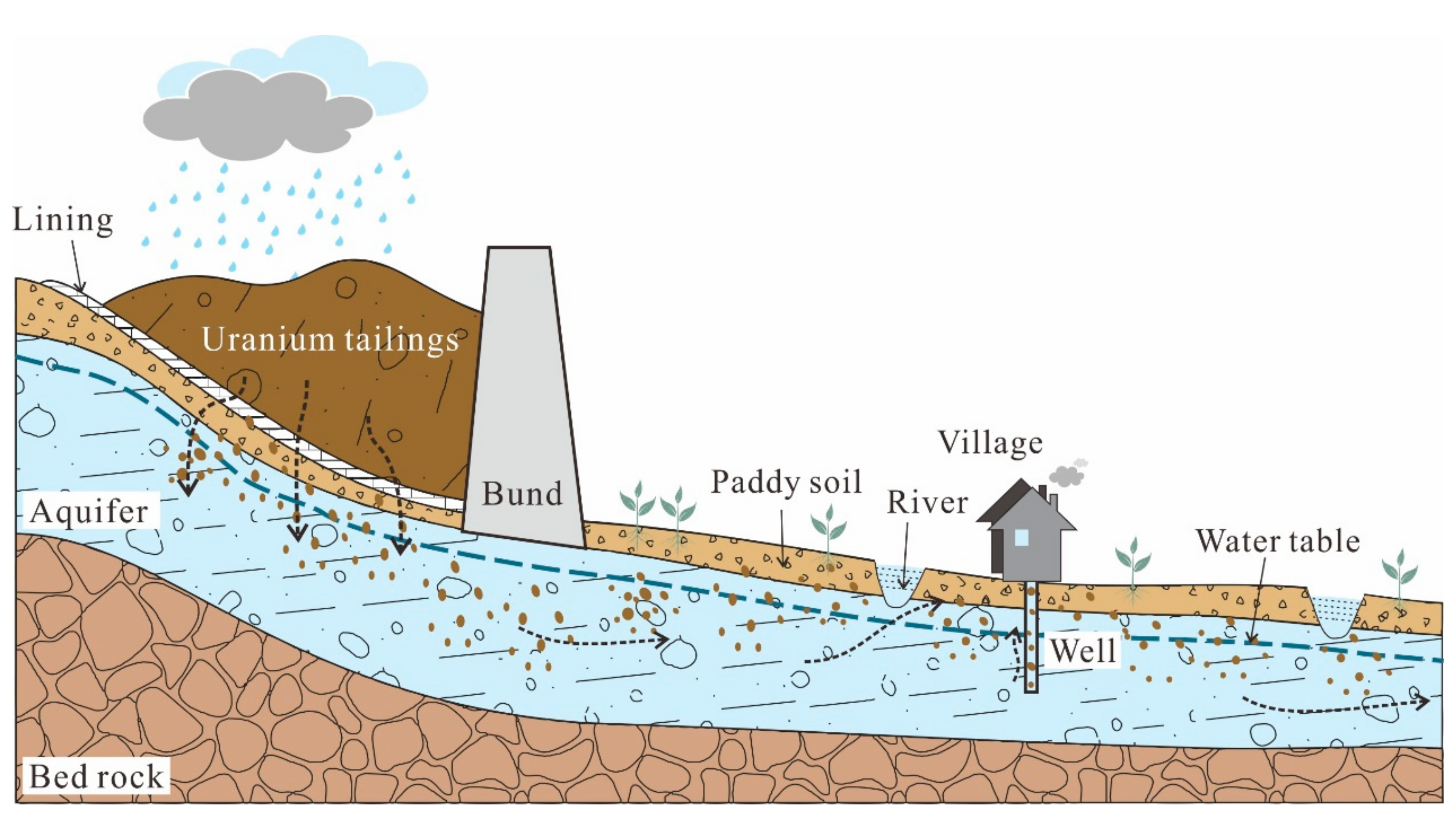
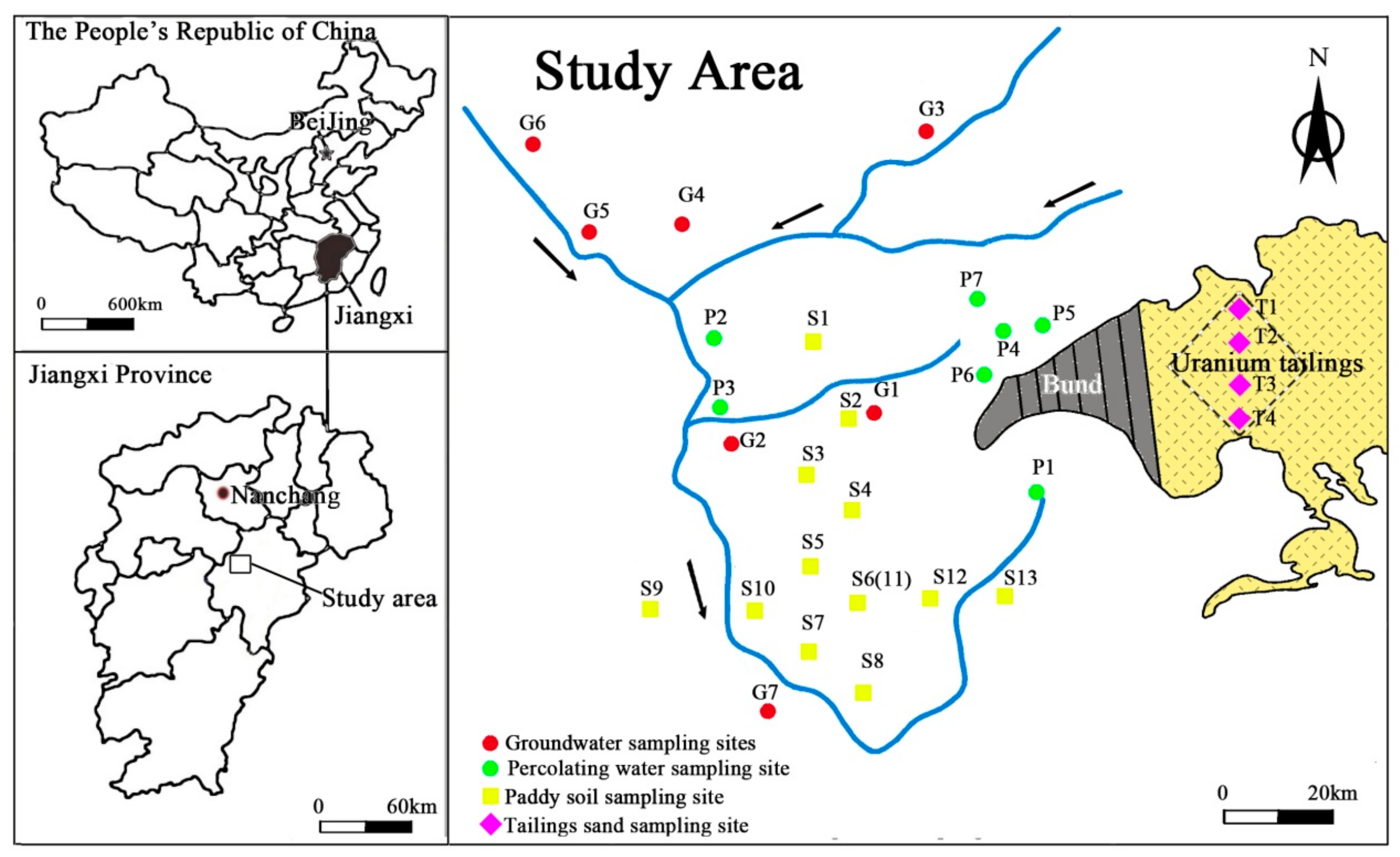
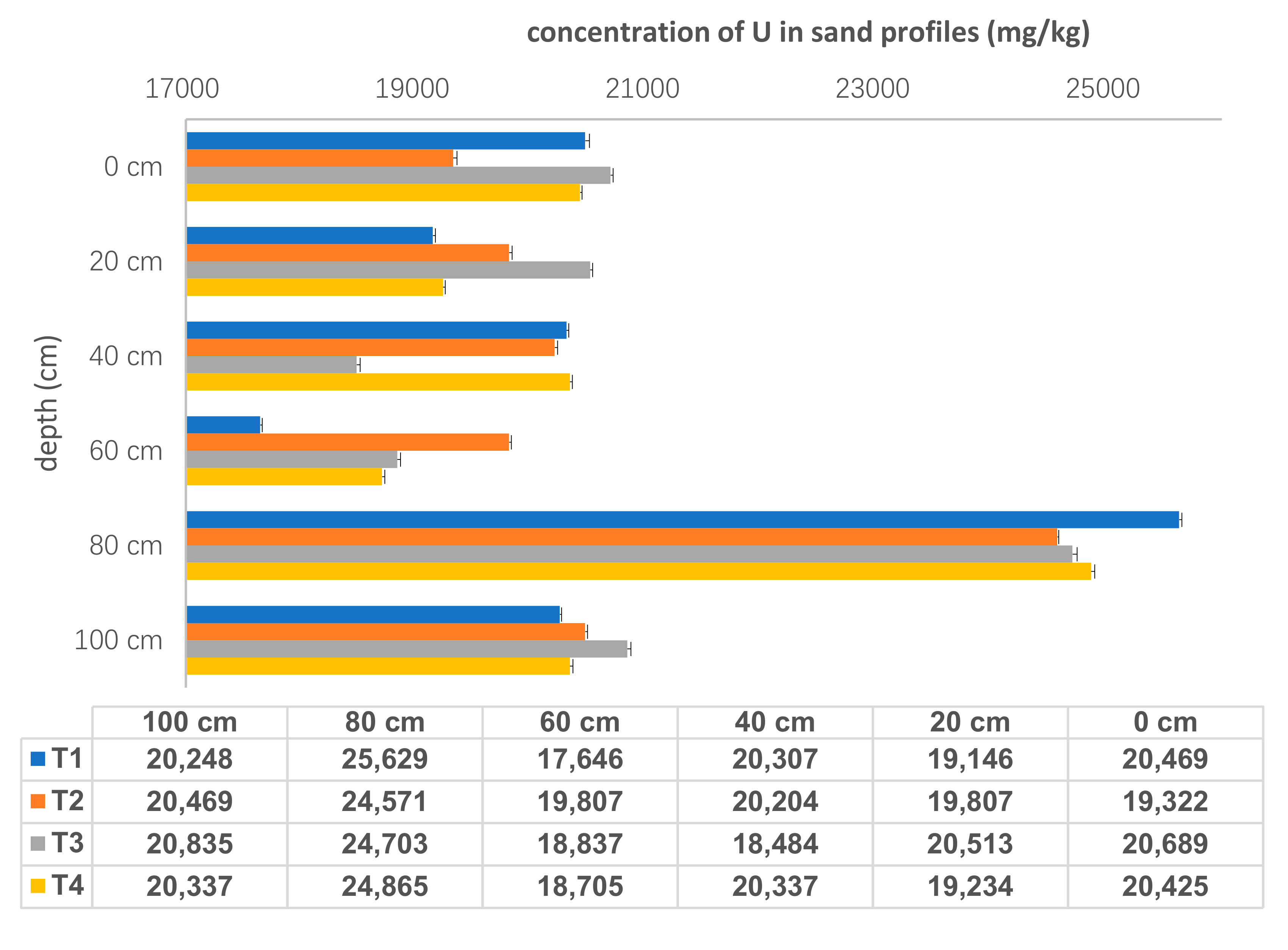
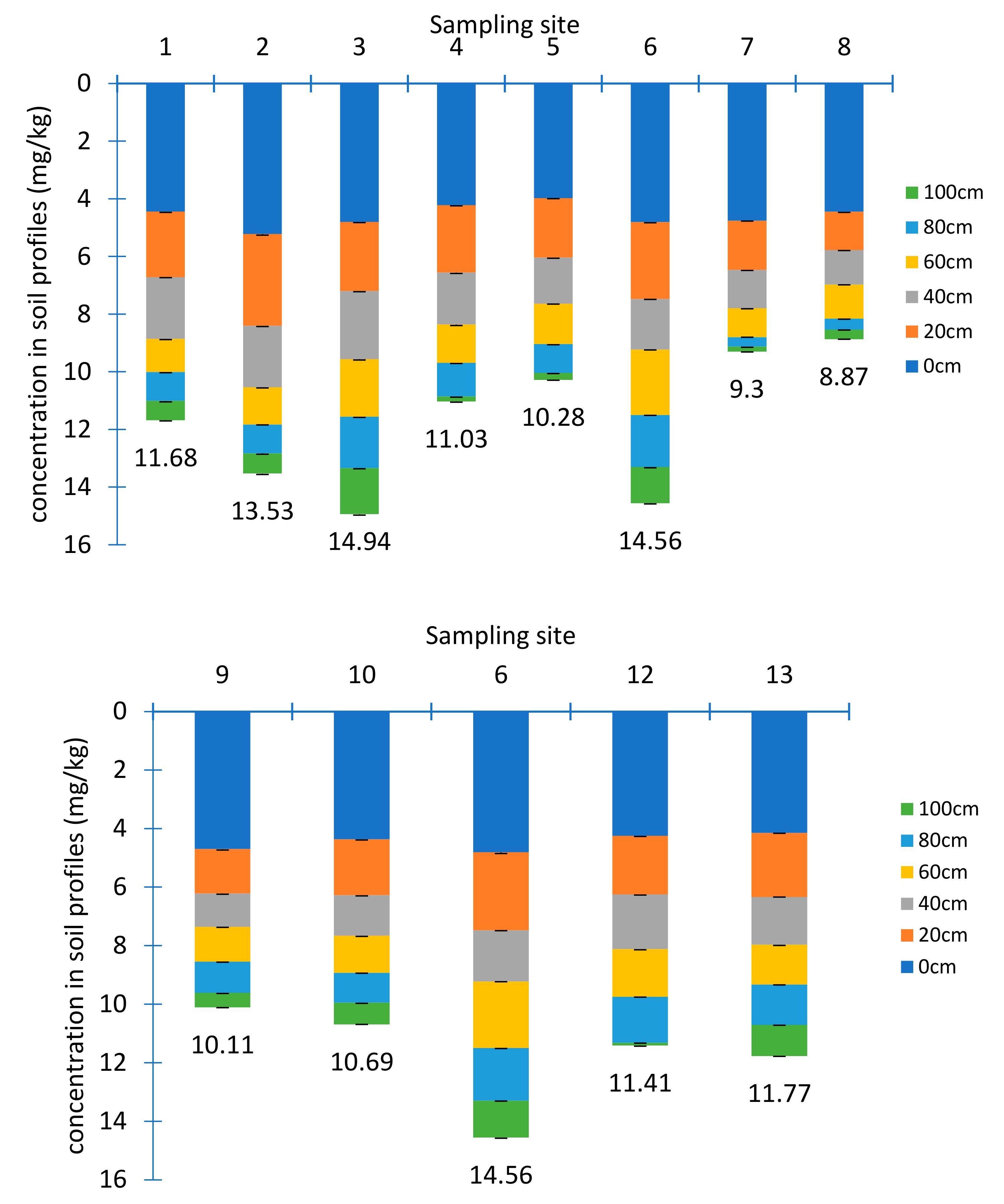
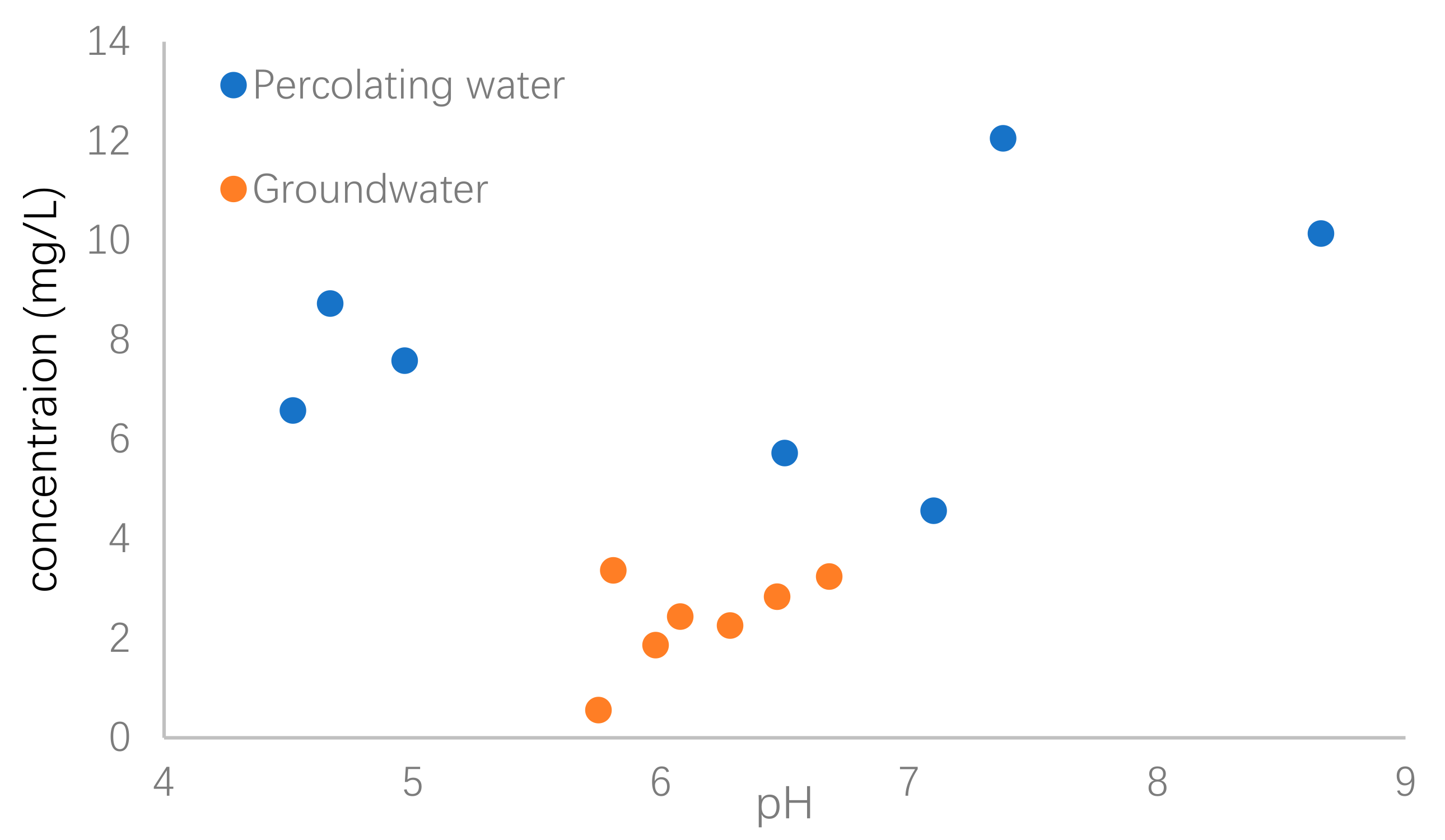
| Points | Description | pH | Concentration (mg/L) |
|---|---|---|---|
| P1 | Tailings pond discharge water | 7.38 | 12.05 ± 0.04 |
| P2 | Sewage treatment plant discharge water | 7.10 | 4.56 ± 0.02 |
| P3 | A village drain water | 6.50 | 5.72 ± 0.01 |
| P4 | B village drain water | 4.67 | 8.73 ± 0.02 |
| P5 | Leakage water from top of tailings pond dam | 8.66 | 10.14 ± 0.03 |
| P6 | Leakage water from bottom of tailings pond dam | 4.97 | 7.58 ± 0.00 |
| P7 | Farmland water near the bottom of tailings pond dam | 4.52 | 6.58 ± 0.01 |
| Points | Description | pH | Concentration (mg/L) |
|---|---|---|---|
| G1 | Drinking well in village A | 5.75 | 0.55 ± 0.04 |
| G2 | A new well in village A | 5.81 | 3.36 ± 0.02 |
| G3 | A new well in village C | 6.68 | 3.24 ± 0.00 |
| G4 | Drinking well in village D | 5.98 | 1.86 ± 0.01 |
| G5 | Drinking well in village D | 6.08 | 2.43 ± 0.01 |
| G6 | Spring in village E | 6.47 | 2.83 ± 0.02 |
| G7 | Spring in village F | 6.28 | 2.25 ± 0.01 |
| Threshold for tailings and inactive sites of USEPA | 0.044 | ||
| Threshold of radiation and environmental protection in U mining of china | 0.05 | ||
© 2020 by the authors. Licensee MDPI, Basel, Switzerland. This article is an open access article distributed under the terms and conditions of the Creative Commons Attribution (CC BY) license (http://creativecommons.org/licenses/by/4.0/).
Share and Cite
Ma, W.; Gao, B.; Guo, Y.; Sun, Z.; Zhang, Y.; Chen, G.; Zhu, X.; Zhang, C. Occurrence and Distribution of Uranium in a Hydrological Cycle around a Uranium Mill Tailings Pond, Southern China. Int. J. Environ. Res. Public Health 2020, 17, 773. https://doi.org/10.3390/ijerph17030773
Ma W, Gao B, Guo Y, Sun Z, Zhang Y, Chen G, Zhu X, Zhang C. Occurrence and Distribution of Uranium in a Hydrological Cycle around a Uranium Mill Tailings Pond, Southern China. International Journal of Environmental Research and Public Health. 2020; 17(3):773. https://doi.org/10.3390/ijerph17030773
Chicago/Turabian StyleMa, Wenjie, Bai Gao, Yadan Guo, Zhanxue Sun, Yanhong Zhang, Gongxin Chen, Xiaojie Zhu, and Chunyan Zhang. 2020. "Occurrence and Distribution of Uranium in a Hydrological Cycle around a Uranium Mill Tailings Pond, Southern China" International Journal of Environmental Research and Public Health 17, no. 3: 773. https://doi.org/10.3390/ijerph17030773
APA StyleMa, W., Gao, B., Guo, Y., Sun, Z., Zhang, Y., Chen, G., Zhu, X., & Zhang, C. (2020). Occurrence and Distribution of Uranium in a Hydrological Cycle around a Uranium Mill Tailings Pond, Southern China. International Journal of Environmental Research and Public Health, 17(3), 773. https://doi.org/10.3390/ijerph17030773





